|
1.
CENTRAL/ WEST AFRICA
Trade startled by Gabon announcement
Dominating the news in the West and Central African
timber trade has been the announcement that Gabon will
ban the export of round logs. The initial news was that the
ban would take effect from January 2010. This
announcement was one of several by the government team
led by the newly-elected President Ali Ben Bongo, who
became Gabon's president last month.
It seems that, so far, no formal gazetting or legislation has
followed. The proposed ban, according to the statement, is
in order to create employment in particular for young
persons and women by ensuring that further processing is
carried out within Gabon.
According to earlier goals, the Government planned to
increase the domestic wood processing rate to 75% in
2012 and only allow 25% of the log harvest to be
exported.
Industry uncertain
At the moment there are no details of any phasing out of
log exports and the industry is uncertain what to do about
the existing log stocks at the port and in transit. It is also
uncertain of what it would do in respect of contracts
already signed and for shipping and time charter
arrangements.
Although Gabon¡¯s log export volumes are much lower
than they were some years ago, there are still large
volumes sold to China, India and lately to Vietnam, as
well as some steady volumes for North Africa.
Consumer countries affected
If the ban was to come into effect in January, these
consumer countries would have just one month in which to
find alternative log supplies to keep their manufacturing
plants operating. Given that there are so few tropical log
exporting countries this will not be easy to achieve and log
prices will likely rise. At this early stage, while waiting for
more detailed information, the market has not reacted.
It is reported that some exporters in Gabon have raised
their asking prices for okoume sawn lumber, though it is
not known if any sales have been made at higher prices.
Major shift in trade pattern
Apart from this major news, there are no reports of price
movements for logs or lumber as it will take time for both
producer and consumer countries to work out strategies to
deal with, what will become, a major shift in trade
patterns. This move will result have consequences for
shipping and investments in processing in one of West and
Central Africa¡¯s major tropical hardwood producing
regions.
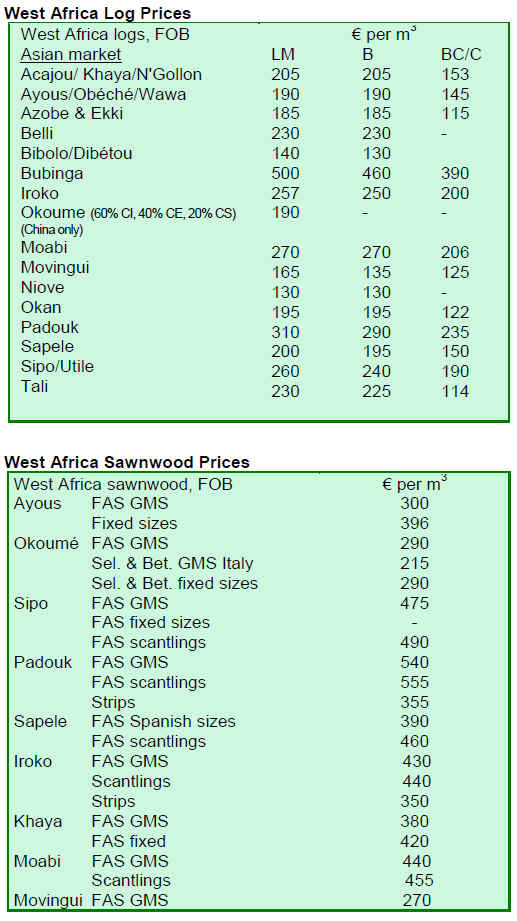
2. GHANA
Ghana¡¯s 2010 Budget
The Minister of Finance and Economic Planning, Dr.
Kwabena Duffour, has presented the 2010 Budget
Statement and Economic Policy to Parliament to usher in
the government¡¯s growth and strategic framework
towards, in his words a ¡®Better Ghana¡¯.
The budget, captioned ¡®Growth and Stability¡¯, enumerated
a set of comprehensive policies to support the
government¡¯s medium term growth strategy in a manner
that would be sustainable.
The statement included element to maintain the
macroeconomic stability and fiscal discipline achieved in
2009, positioning the country in five areas of investment
for a sustained growth through the modernisation of
agriculture, provision of key infrastructural development,
oil and gas projects, private sector development, ICT and
delivery of social programmes targeted at poverty
reduction.
The implementation of this agenda is projected to cost
government GHc10.8 billion in total payments, 23 percent
higher than the 2009 budget.
The Minister said that monetary policy would continue to
focus on stabilising price and exchange rate expectations,
saying the goal of the monetary policy was to reduce
inflation rate to less than 10 percent over the medium
term.
By a legislation instrument, the Government is to integrate
the three revenue agencies of Value Added Tax (VAT),
Customs Excise and Preventive Services (CEPS) and
Internal Revenue Service (IRS) into one agency to be
known as Ghana Revenue Authority.
Budget statement highlights
• A significant reduction in the budget deficit from
22 percent of GDP to about 10 percent,
• Improvement of import cover from 1.8months in
2008 to 2.5months in 2009,
• Job Creation through Greening Ghana,
• Provision of GHc25.0 million for the
establishment and the implementation of the
Savannah Development Authority.
Deficit cut
Ghana¡¯s budget deficit will, according to latest estimates,
narrow to 7.5 percent of gross domestic product next year
as the government looks to earn more from import duties
and mining.
Interest rates
Meanwhile, the Bank of Ghana has cut its prime interest
rate by 0.5% to 18.0 percent. The newly appointed
Governor Kwesi Amissah-Arthur, chairing his first
meeting of the bank's Monetary Policy Committee,
announced the reduction at a news conference. The
previous level of 18.5 percent represented a five-year high.
Royalties to Government
Golden Star Resources Ghana Ltd, whose mining
activities are under the jurisdiction of the Ministry of
Lands, Forestry and Mines, has paid US$8 million in
royalties to the government. This was royalties for the
third quarter and they were derived from its two mines in
Bogoso/Prestea and Wassa, Western Region. Since
Jan.2009, the company has paid US$27.9 million in
royalties to the Ghana government.
In a related development, the 2010 budget statement
indicated that royalties paid by mining companies are to be
increased from three to six percent.
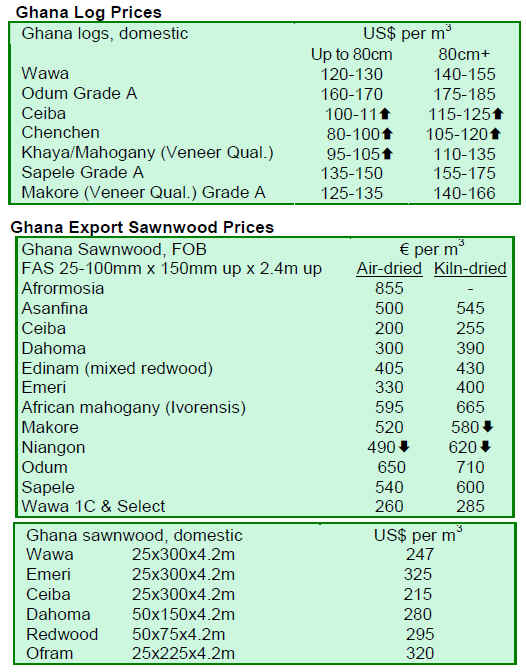
3.
MALAYSIA
China investment plan
China, which is one of Malaysia¡¯s biggest trading partners,
will seek further trade and investment opportunities in the
country in the area of oil palm and timber. This emerged
during a press conference held jointly with the visiting
Chinese president Hu Jintao.
China is fast becoming a major buyer of Malaysian
sawnwood, plywood and logs and forecasts are for its
economy to grow by more than 9% in 2010 driven by
growing domestic consumption and exports.
Expectations are high for increased wood consumption
following the government planned low-cost housing
programme. This aims to provide 7.5 million homes to
low-income urban households from 2009 to 2011.
India major player
India¡¯s timber imports in 2008 were around US$1.4
billion, out of which, US$362.8 million (RM1.3 billion)
originated from Malaysia. This made India Malaysia¡¯s
third largest timber trading partner after the US and Japan.
Products exported to India include logs worth US$263
million (RM920 million), mainly from Sarawak and
wooden furniture worth US$44.8 million (RM156.8
million). A recent trade mission by the Malaysian Timber
Council (MTC) to Delhi, Mumbai and Chennai identified
that India is expected to remain a major importer due to its
large population and growing middle-class income group.
Gluelam plan
Plans to promote glued-laminated (glulam) timber
products are being developed by the MTC in order to
assist local manufacturers. MTC hopes to emulate the
success of its competitors in their successful promotional
efforts in Dubai, New Zealand and in Hong Kong.
To further enhance its market promotion the MTC will be
organising training programmes for overseas architects,
designers and manufacturers in the near future. The MTC
is reportedly targeting countries where Malaysian timber
products are not widely marketed.
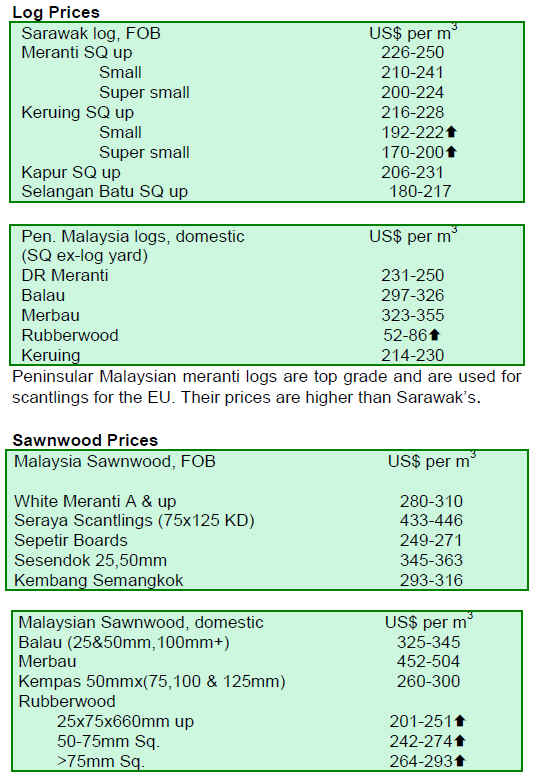
4.
INDONESIA
Furniture selling well
In what is being heralded as growing worldwide
appreciation of Indonesian furniture products, companies
secured orders said to be worth over US$380,000 during
the Middle East International Furniture and Interior
Design Exhibition (INDEX) 2009, which was held from
November 14 to November 17, 2009, at the Dubai World
Trade Centre.
The head of the national exports development agency said
that the interest in Indonesian furniture supported the view
that Indonesian timber products are gaining acceptance in
the Middle-Eastern countries, Pakistan, East Asia and
Africa. At the fair Indonesia was represented by 21
companies including some agencies operated by
governmental institutions.
The fair had exhibits from 1,750 companies and agencies
including Malaysia, Taiwan PoC, Vietnam, and China.
Import duty cut
The Indonesian government will abolish the 5% import
duty imposed on machinery and raw material for 7 critical
industries in an effort to boost investment and to increase
the global competitiveness of Indonesian companies.
The Ministry of Finance added that the tax would be
abolished as of December 16, 2009 for a trial period of
two years when a review of its effectiveness will be
undertaken.
The industries set to benefit from the change in duty
include the transportation, telecommunications, public
health, tourism and culture, as well as, supporting
industries for the mining, construction and port and
harbour services. The move is seen as an encouragement
for domestic industries to open new plants or businesses.
At present it is not clear how this will assist investors in
the wood processing sector.
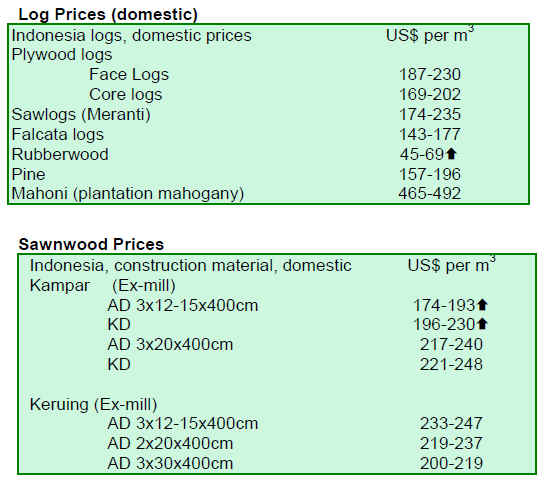
5.
MYANMAR
Teak sawmilling a sunset industry
An article highlighting the alarming decline of the
sawmilling industry in Myanmar appeared in ¡®Living
Colour¡¯- a monthly economic news magazine- this showed
that Myanmar¡¯s timber is, today, exported mainly in log
form and not as processed products. The following table
illustrates the trends in log exports and domestic
manufacturing.
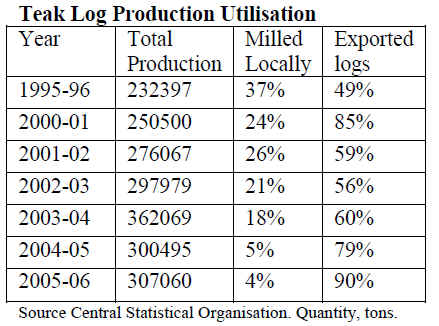
The author of the article traced back into the 17th & 18th
centuries when teak was originally the favoured timber for
shipbuilding. After independence the industry was
managed by the State and the then two sawmills converted
15,725 hoppus tons of logs. The number of teak sawmills
had increased to 34 by 1968-69 and by 1983-84 teak
sawmilling had reached a peak with some 335,000 hoppus
tons being milled. Beginning in 2000, mill throughput
declined with the lowest level (10,800 hoppus tons) being
recorded in 2005.
The author advocated the need to stimulate the local
industry from slipping further and was well received
among the wood industrialists.
Sino-Myanmar border trade
A vernacular weekly in Myanmar ¡®7-Days News¡¯ carried a
story, quoting Global Witness, saying that the trade in
illicit timber declined by 70% between 2005 and 2008.
This was attributed to the efforts by the authorities in
China and Myanmar.
Analysts mentioned that the past undocumented trade in
wood into China not only adversely affected the Myanmar
wood industry, but also some major Thai sawmills. The
result was that timber buyers were sourcing their sawn
teak in China and the industry in Myanmar and Thailand
were unable to compete with the cheaper teak products.
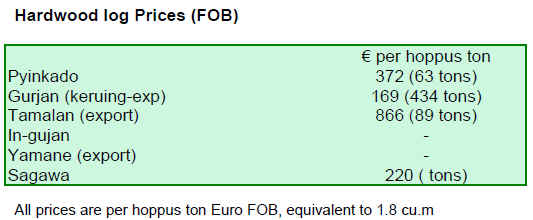
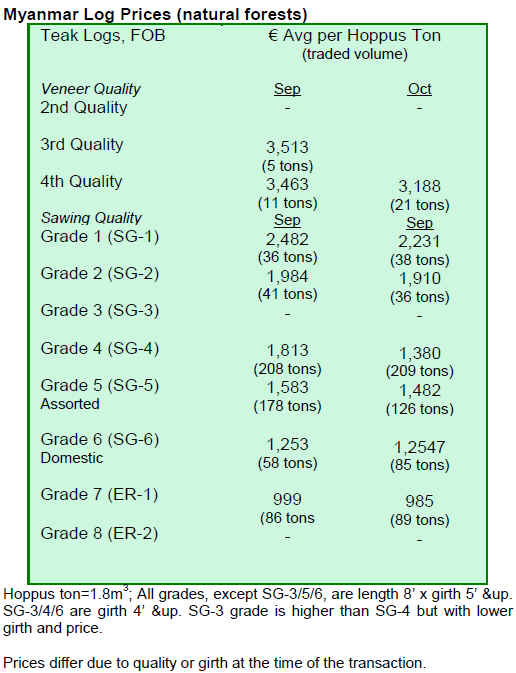
6. INDIA
Demand strong
With the Indian Rupee at 46.22 to one US dollar there has
been a surge of 14% in the dollar from its record low of
Rs.52.20 reached in March. This jump has put exporters in
difficult spot and in October there was a drop of almost
12% in exports according to official figures.
China is one of the key competitors for Indian exporters
along with Vietnam, Bangladesh and Sri Lanka.
Nevertheless demand for hardwood products continues to
be good and the slightly lower prices seen for logs from
Myanmar and other sources has helped exporters adjust to
the dollar strengthening.
On export front the performance has been steady and
consistently improving as seen from the following
figures:
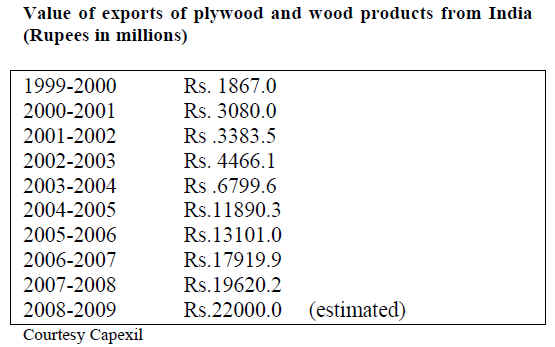
Indian consumption grows
Wood consumption in Indian is growing fast and although
the country has over 250 commercial timbers (including
some of the most highly prized tropical hardwoods like
Teak, Rosewood, Padouk, Red Sanders, Sandalwood) a
strict conservation policy limits harvesting. This means
India is a net importer of wood and wood-based panel
products. Indian industrial demand for wood jumped from
58 million cubic meters in 2000 to 85 million cu.m in
2008 and expected to cross 150 million cu.m by 2018.
India manufacturers prefer to import timber in log form to
feed the domestic industries. Imports are mostly from
Malaysia, Myanmar, Indonesia, Nigeria, Ivory Coast,
Ghana, Togo, Gabon, Brazil, Panama, Costa Rica,
Ecuador and New Zealand. The major ports used for
imports are Kandla, Mumbai, Mangalore, Tuticorin,
Chennai Vishakhapatnam and Kolkata as well as many
internal container depots.
Requirement for logs for the panel industry is met largely
from plantations, Agro-forestry sources and natural
forests. The concept of industry owned plantations of
Eucalyptus, Poplar, Casuarinas and Acacia mangium is
gaining popularity and this helps a lot in preventing illegal
fellings from state forests. Teak harvesting is handled by
the government Forestry Agencies and sales are made by
auction at forest depots. Even the private logs are brought
to the official depots for sale by auctions.
Auction prices
Auction prices for Teak logs at Government Forest depots
have continued to be firm as domestic demand exceeds the
quantity available.
Adina cordifolia has been fetching Rs.300 to 350 per
hoppus foot while Terminalia tomentosa has been selling
for Rs.350 for A grade, Rs.200 to Rs.250 for B grade and
Rs.200 to Rs.150 for C grade logs. All prices are per cubic
foot (Hoppus) ex depot.
Plantation incentives
Besides industrial plantations, Sandalwood (Santalum
album) and Red Sanders (Pterocarpus santalinus) are also
now the focus of attention due to improved and relaxed
rules and regulations for the growing and harvesting these
high price exotic species.
There is plenty of scope for raising private plantations for
these high value timbers as well as Teak. Now even
Bamboo is being promoted by the Indian government as it
is fast growing and finds many uses especially for the
paper and rayon industries. The role of Bamboo is
expected to boost the economy, the greening projects and
carbon sequestration.
Imports
Trade analysts are reporting that import prices are steady
as flow of arrivals is good. However the availability of
timbers from Myanmar seems to be getting less and less
but the expectation is for improved qualities of overseas
plantations of Teak. The recently improved quality of
plantation Teak from Ghana, Benin, Sudan and Tanzania
are helping meet the shortages from Myanmar and
supplies from Central and Latin American countries are
also expected to get better as the plantations are getting
older.
The current prices for Teak imported from various sources
other than Myanmar are shown below. All rates are per
cubic meter C&F Indian ports.
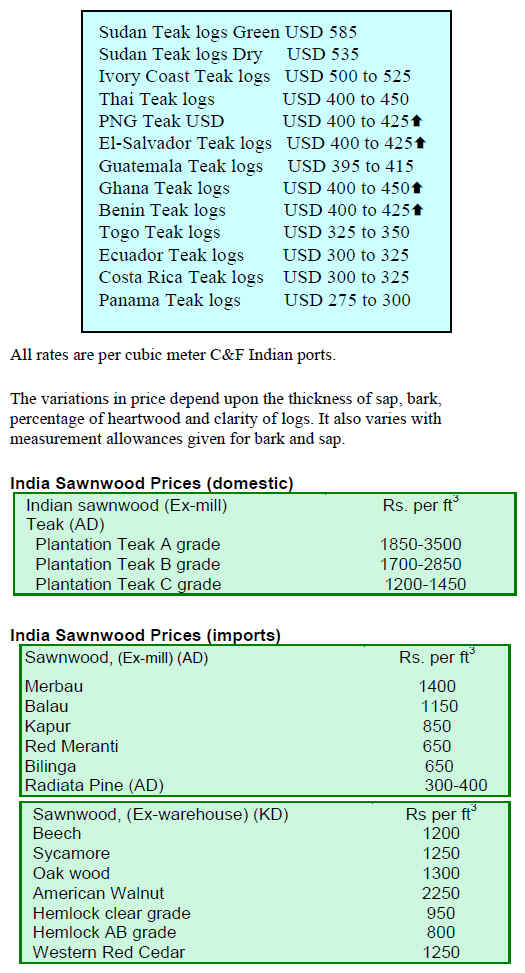
7. BRAZIL
Real appreciates further
Prices of wood products in local currency remain stable
but prices in US$ have increased about 4.9%. This is due,
primarily, to the appreciation of the Brazilian Real against
the U.S. Dollar over the period under review.
Consumer price index
The Consumer Price Index (IPCA), which measures the
official inflation rate in Brazil, closed at 0.28% in October.
This is 0.04% above the rate in September according to the
Brazilian Institute of Geography and Statistics (IBGE).
From January to October, the accumulated inflation was
3.5%, below the inflation in the same period of 2008
(5.2%).
Given the perspectives for inflation compared to the
government target, the Monetary Policy Committee
(Copom) of the Central Bank of Brazil maintained the
Selic rate at 8.75% per year. The next meeting of Copom
will be held on early December.
In October 2009, the average exchange rate was BRL
1.74/US$, compared to BRL 2.17 in the same month of
2008. The continued strengthening of the BRL against the
US dollar is of concern to exporters.
Manufacturers at full capacity
The furniture sector in the Sinop region, in the Amazon, is
celebrating positive business trends for the year end, due
mainly to the increases seen in furniture production to
supply retailers to meet demand. While sales projections
are influenced by many factors manufacturers are
optimistic and say the outlook is favorable.
The manufacturers are reportedly operating at maximum
production capacity and the furniture sector is booming in
the region. The prospects for 2010 are said to be good.
In the municipalities of Sinop, Sorriso, Lucas do Rio
Verde, Nova Mutum, Vera and Tapurah, members of the
Local Production Arrangement (APL), have proposed
increasing revenues by 30% by 2011 which would require
a jump in sales of over R$ 19 million.
In 2008 in the municipalities mentioned, the gross annual
revenues of the furniture sector reached R$ 14.8 million,
derived from sales to some 7.3 million consumers. Sales
outside of the municipalities of origin of companies
totaled more than R$ 2 million.
Exports drop
In October 2009, exports of timber products (except pulp
and paper) fell 31.4% compared to values from October
2008, from US$ 292 million to US$ 200.2 million.
Pine sawnwood exports fell 46% in value in October 2009
compared to the same month of 2008, from US$ 18.7
million to US$ 10.1 million. In volume, exports decreased
38.8% from 60,300 cu.m to 36,900 cu.m over the period.
Exports of tropical sawnwood also fell significantly in
both volume and value, from 75,200 cu.m in October 2008
to 51,600 cu.m in October 2009, and from US$ 40 million
to US$ 26 million, respectively over the same period. This
translates to a 31.4% fall in volume and 34.5% in value.
Pine plywood exports dropped by 34.4% in value in
October 2009 compared to the same period of 2008 and
from US$37.2 million to US$24.4 million. The volume
exported decreased 25% during the same period, from
125,000 cu.m to 93,700 cu.m.
Exports of tropical plywood fell once more from 17,600
cu.m in October 2008 to 11,300 cu.m in October 2009,
representing a 35.8% decline. In terms of value, a 44%
reduction was recorded over the period, from US$ 11.6
million to US$ 6.5 million.
In respect of wooden furniture, export revenues fell from
US$ 71.1 million in October 2008 to US$ 52.1 million in
October 2009, representing a 26.7% drop.
Furniture export to Argentina fall
Despite ongoing negotiations between Brazil and
Argentina on ending trade barriers, protectionist measures
by Argentina are affecting the furniture sector of Rio
Grande do Sul, the Brazilian Southernmost state.
According to the Rio Grande do Sul State Foundation for
Economics and Statistics (FEE), furniture exports dropped
53% from January to September 2009.
Dubai Furniture Fair
A group of 23 Brazilian companies exhibited their
products at the Middle East International Furniture and
Interior Design Exhibition (INDEX) 2009 held in Dubai.
This is one of the largest furniture fairs in the region.
The fair brought together the most important companies in
furniture production, and related sectors. The participation
of the Brazilian companies was an initiative of the
Brazilian Furniture Project, developed by the Brazilian
Furniture Manufacturers Association (ABIMÓVEL) in
partnership with the Brazilian Agency for Export and
Investment Promotion (Apex).
In the first half of this year the Middle Eastern countries
imported Brazilian furniture worth around US$ 1.5. The
Middle East is a large consumer market and remains
important for Brazilian exporters despite the current
economic crisis.
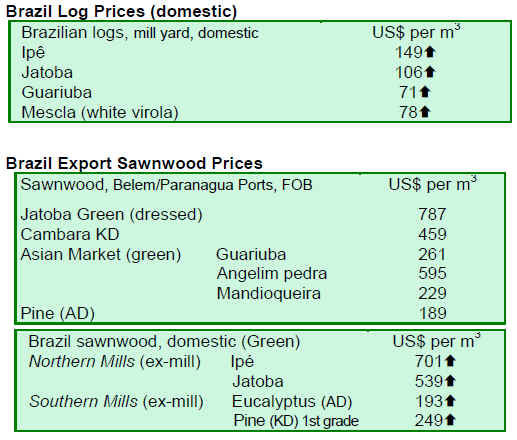
8.
PERU
Exports down 39%
According to the Export Association of Peru (ADEX),
wood sector exports from January ¨C September 2009 were
worth US$105 million FOB while for the same period in
2008 they were US $174 million a drop of almost 40%.
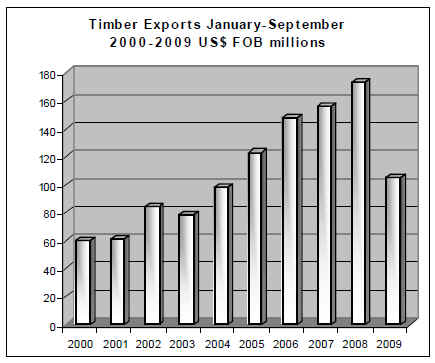
In the January ¨C March quarter, the three main wood
export markets were China, Mexico and the United States
and these three accounted for 79% of wood sector exports.
In the first three quarters of the year the Bolivia market
emerged as significant with its imports of mainly plywood
and parquet jumping more than 350% the same period in
2008.
New Zealand also represented a growing market with its
imports from Peru more than tripling on 2008. New
Zealand imported a large quantity of sleepers (railway
cross-ties HS 440690).
Weak Mexican demand
On the other hand, the Mexican market weakened with
overall wood imports from Peru dropping 64% and
imports of mouldings ceased altogether! A similar picture
emerged in Canada where imports from Peru were down
63%.
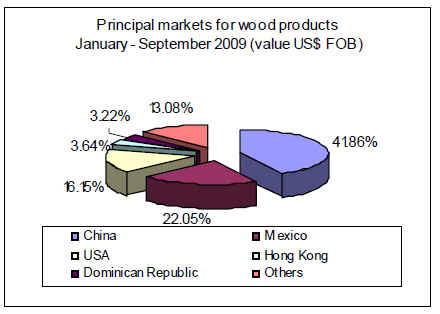
Semi manufactured exports hit
Exports of semi-manufactured products accounted for
40% of the total trade in wood products.
The main export destination for products in this sub-sector
was China (76%). On the other hand, the market in Hong
Kong grew strongly.
The Sawnwood export in the first three quarters
represented the second largest export sector at 37% of all
wood products exported and they were worth US$39
million FOB down 51% on the same period in 2008.
The main market for sawnwood was Mexico, taking 35%
of exports.
Exports of veneer and Plywood in the first three quarters
stood at US$11 million FOB down over 50% with Mexico
taking the biggest share at 82% of all veneer and plywood
exports.
The exports of furniture and parts dropped 42% in the
period January ¨C September 2009 to US$ 5.5 million FOB.
The US is the largest market for Peru¡¯s furniture and parts
exports accounting for around half of all furniture exports.
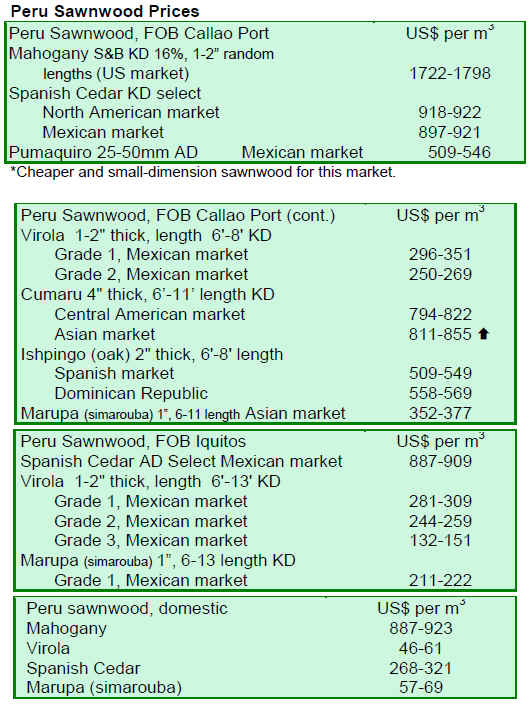
9. BOLIVIA
Small enterprises dominate
In Bolivia there are round 1300 wood processing
industries of which an estimated 73% are small
enterprises. Currently, the FSC system is being adopted by
private companies so that, through certification, they can
gain better access to international markets.

10. MEXICO
Climbing out of recession
Reports are indicating that Mexico¡¯s gross domestic
product fell by 6.2 percent in the third quarter relative to
the same period of 2008 authorities said.
Year-on-year output in the service sector fell by 6.5
percent, industrial production was down 6.6 percent and
¡®primary¡¯ activities (agriculture and livestock) were also
down.
However on a quarter-on-quarter basis a picture of a
recovery is emerging with industrial production up around
2% relative to the second quarter, while services improved
almost 4% but agricultural and livestock production
remained in negative territory.
The Mexican economy began shrinking at the end of 2008,
and GDP continued to decline in the first two quarters of
this year, falling 8.2 percent and 10.2 percent,
respectively.
The Mexican economy has been badly hit by falling
exports to the US and lower remittances from overseas
workers as well as a decline in oil production. However,
the indications are that the country has climbed out of the
worst of this recession.
CONAFOR News
The Sierra de Organos National Park, a protected natural
area of 1,125 ha. in the state of Zacatecas, is the target of
action under the CONAFOR restitution of environmental
services and land recovery project. Up to 2010 some 23
million pesos from the Mexican Forest Fund will be used
by the project.
11.
Guyana
Price movements
Greenheart log prices for only standard sawmill quality
shifted moderately, while Purpleheart log prices for
standard sawmill quality and fair sawmill quality remain
relatively stable.
Mora log prices moved up over the past two weeks
recording higher average prices for all grades (standard,
fair and small).
Sawnwood prices for undressed (rough sawn) Greenheart
(select) have not changed but prices for merchantable
grade fell. On the other hand undressed (rough sawn)
Mora select increased to the range of US$ 500/592.
Dressed Greenheart prices fell while dressed Purpleheart
prices moved up to between US$ 813/900 in comparison
to the previous period.
Baromalli BB/CC plywood prices recorded higher average
prices for the period under review.
Demand trends
Roundwood exports contributed to export earnings and
prices were steady. Splitwood exports contributed
favourably to earning with higher average prices as against
prices in the previous period.
For value added products the contribution of doors and
indoor were favorable having achieved higher average
prices as compared to prices in October.
Outdoor garden furniture is also making a significant
contribution to export earning as is trade in window
frames and non timber forest products.
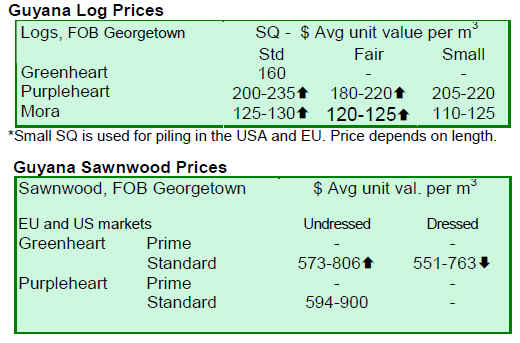
|